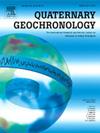Combined single grain and cobble luminescence dating of poorly bleached glaciofluvial deposits from the Swiss Alpine foreland
IF 1.7
2区 地球科学
Q3 GEOGRAPHY, PHYSICAL
引用次数: 0
Abstract
Constraining the age of glaciofluvial deposits is essential for reconstructing paleoglacial dynamics. While luminescence dating is among the most commonly used approaches, incomplete resetting of the signal before sediment deposition makes its application to such deposits challenging. Single grain (SG) and cobble luminescence dating have been used to account for heterogeneous bleaching with different success, and are tested here in combination on glaciofluvial deposits from one site in the northern Alpine foreland. Previous chronological investigations indicate that deposition of the proglacial outwash occurred ca. 29 ka ago. SG feldspar results on sand lens and gravel sandy matrix samples underestimate the previous age estimates due to the occurrence of grains with low equivalent dose (De) values. When low De values are discarded, the estimated ages are in agreement with the independent constraints. Luminescence-depth profiles obtained from four cobbles show (1) no or only shallow bleaching, and (2) high variability between cores and surfaces of the same clast. Both aspects highlight the necessity of measuring numerous clasts and several cores in order to detect well-bleached clasts and profiles. The limited signal resetting can be explained by the proximity of the deposit to the glacial front. The intra-cobble variability is instead potentially related to heterogeneity in the cobbles’ lithology, implying differences in dosimetry, signal stability and light attenuation within the clasts. Electron microprobe analyses of feldspar in the clasts and comparison with the independent age constraints suggest that (1) the luminescence signal of the rock slices derive from both Na- and K-rich feldspars and (2) an average internal potassium content may be a good first order estimate for dose rate calculations. Overall, the present study highlights both the challenges and the potential of applying SG and cobble luminescence dating to partially bleached glaciofluvial deposits.
瑞士阿尔卑斯前陆浅白化冰川河流沉积物的单粒和卵石联合发光定年
确定冰川河流沉积的年龄是重建古冰川动力学的必要条件。虽然发光测年是最常用的方法之一,但在沉积物沉积之前不完全重置信号使其应用于此类沉积物具有挑战性。单粒(SG)和鹅卵石发光测年法已被用于解释非均质白化,取得了不同的成功,并在北阿尔卑斯前陆的一个地点结合冰川河流沉积物进行了测试。以往的年代学研究表明,前冰期冲洗液的沉积发生在大约29 ka以前。砂透镜体和砾石砂基质样品的SG长石结果低估了以前的年龄估计,这是由于出现了低当量剂量(De)值的颗粒。当丢弃低De值时,估计的年龄符合独立约束。从四个鹅卵石中获得的发光深度剖面显示:(1)没有或只有浅漂白,(2)同一碎屑的岩心和表面之间具有很高的变异性。这两个方面都强调了测量大量的碎屑和多个岩芯的必要性,以便检测漂白良好的碎屑和剖面。有限的信号重置可以用沉积物靠近冰川前缘来解释。相反,鹅卵石内部的变异性可能与鹅卵石岩性的非均质性有关,这意味着碎屑中剂量学、信号稳定性和光衰减的差异。对岩屑中长石的电子探针分析和与独立年龄约束的比较表明:(1)岩屑的发光信号来自富钠长石和富钾长石;(2)平均内部钾含量可能是计算剂量率的良好一级估计。总的来说,本研究强调了将SG和鹅卵石发光测年应用于部分漂白的冰川-河流沉积物的挑战和潜力。
本文章由计算机程序翻译,如有差异,请以英文原文为准。
求助全文
约1分钟内获得全文
求助全文
来源期刊

Quaternary Geochronology
地学-地球化学与地球物理
CiteScore
4.40
自引率
22.20%
发文量
130
审稿时长
20 weeks
期刊介绍:
Quaternary Geochronology is an international journal devoted to the publication of the highest-quality, peer-reviewed articles on all aspects of dating methods applicable to the Quaternary Period - the last 2.6 million years of Earth history. Reliable ages are fundamental to place changes in climates, landscapes, flora and fauna - including the evolution and ecological impact of humans - in their correct temporal sequence, and to understand the tempo and mode of geological and biological processes.
 求助内容:
求助内容: 应助结果提醒方式:
应助结果提醒方式:


